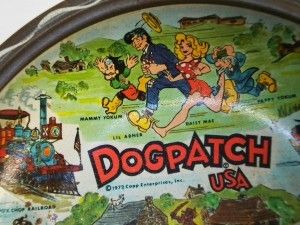Y'all ever hear about a lil' ol' place name o' Dogpatch ?

Born Alfred Gerald Caplin, the cartoonist genius behind Li'l Abner was better known as
Al Capp.
At the age of 9, he lost his left leg in a trolley accident, obviously having a huge impact on his life, and worldview, from then on. Encouraged by an artistically inclined father, Capp cartooned and became the youngest syndicated cartoonist in America at the age of 19 working on the AP's Colonel Gilfeather. Far too boring for Capp, he hired on with Ham Fisher ghosting his Joe Palooka strip. Eventually tiring of the overbearing Fisher he left to create his own strip.
At the age of 25, Capp took his hillbilly idea to United Features Syndicate and Li’l Abner was born.
Hardly “li’l,” Abner was a hulking, naive man-child, and the frequent foil for Capp’s satiric stories about American life and politics. This simple-minded citizen of humble Dogpatch was a paragon of virtue in a dark and cynical world. Abner often found himself far from home, whether in the company of unscrupulous industrialist General Bullmoose, in hapless snowbound Lower Slobbovia, or wherever Capp’s whimsical and often complex plots led our heroic hillbilly.
Li’l Abner was the unlikely son of tiny Mammy (Pansy) and Pappy (Lucifer) Yokum. Mammy was the industrious “sassiety leader” of backward Dogpatch who instilled honesty and All-American ideals in Li’l Abner. Pappy, in contrast, was an illiterate and hopeless parasite. From the inception of the strip, Abner was vigorously pursued by Daisy Mae, a beautiful Dogpatch damsel hopelessly in love with the bumbling, unappreciative and seldom amorous bachelor. Abner spent nearly two decades outracing Daisy in the annual Sadie Hawkins Day race but the couple finally married in 1952, a fictional event that captured national attention and was a cover story for Life magazine. Their only child, Honest Abe, was born in 1953.
Li’l Abner generally had no visible means of support but he sometimes earned his living as a mattress tester. When not involved in worldwide escapades, he was engrossed by his favorite “comical strip,” Fearless Fosdick. He interacted with many marvelous and fantastic characters creating language and situations which have become permanent parts of the American lexicon.
Abner was started in only eight newspapers, but Dogpatch struck a nerve in Depression-era America. Within three short years it had climbed to 253 newspapers, reaching over 15,000,000 readers. Before long he was in hundreds more, with a circulation exceeding 60,000,000. At a time when syndicates owned the copyrights, trademarks and merchandise rights to comic strips, Capp wrested control of “Li’l Abner” from United Features, an almost unprecedented event.
Besides entertaining millions, Capp permanently affected the popular culture. In 1937 he introduced the annual Sadie Hawkins Day race into his strip. It quickly inspired real life girl-asks-boy dances across America and Sadie Hawkins Day became a national institution. In 1948 his lovable Shmoo characters became a national sensation, creating the largest mass merchandising phenomenon of its era, followed on its heels by the Kigmy. After nearly 20 years of prominent bachelorhood, Li’l Abner finally married Daisy Mae in 1952, an event that shocked the country and made front page news.
Capp’s celebrity admirers ranged from actor/director Charlie Chaplin, writer John Updike and economist John Kenneth Galbraith. Author John Steinbeck was not only a fan, in fact, he called Capp “the best writer in the world.” Capp speckled his wild narratives with unforgettable characters – among them heartless capitalist General Bullmoose; human jinx Joe Bfstplk, who was followed by his own bleak rain cloud; Evil Eye Fleegle whose double whammies could melt skyscrapers; cave-dwelling buddies Lonesome Polecat and Hairless Joe who concocted Kickapoo Joy Juice, the ultimate moonshine; Mammy Yokum, the sweet old lady who could outbox men twice her size; fumbling detective Fearless Fosdick, whose bullet-riddled body resembled Swiss cheese; and the gorgeous but odorous Moonbeam McSwine who preferred the company of pigs to men. And when readers thought there was no sadder and poorer place than Dogpatch, Capp would take his readers to frostbitten and poverty stricken Lower Slobovia. It is no surprise that the colorful Li’l Abner cast inspired a long-running Broadway musical in 1957 and two film adaptations.
In addition to the enormous popularity of his comic strip, Capp’s fame stemmed from a high media profile. He was a frequent and outspoken guest on the “Tonight” show, spanning hosts Jack Paar, Steve Allen and Johnny Carson. He authored his own newspaper column and radio show and was a guest lecturer at campuses nationwide. Capp retired the strip in 1977 and died two years later. Capp’s “Li’l Abner” stands the test of time as a pinnacle of cartoon art and social satire.
The strip ran from 1934 to 1977. Capp died two years later.